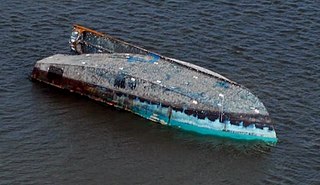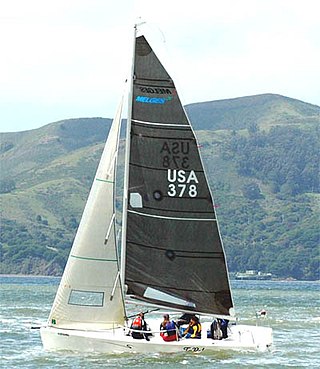
A sailboat or sailing boat is a boat propelled partly or entirely by sails and is smaller than a sailing ship. Distinctions in what constitutes a sailing boat and ship vary by region and maritime culture.

The metacentric height (GM) is a measurement of the initial static stability of a floating body. It is calculated as the distance between the centre of gravity of a ship and its metacentre. A larger metacentric height implies greater initial stability against overturning. The metacentric height also influences the natural period of rolling of a hull, with very large metacentric heights being associated with shorter periods of roll which are uncomfortable for passengers. Hence, a sufficiently, but not excessively, high metacentric height is considered ideal for passenger ships.

The Zodiac Milpro Futura Commando 470 or in short FC470 Combat Rubber Raiding Craft (CRRC), also known as the "Combat Rubber Reconnaissance Craft," is a specially fabricated rubber inflatable boat often used by the U.S. Navy, U.S. Marine Corps, the U.S. Army, and others. The CRRC is typically called "Zodiac," referring to the boat's manufacturer, Zodiac Milpro.

The Chicago Yacht Club Race to Mackinac is a 333-mile annual yacht race starting in Lake Michigan off Chicago, Illinois, and ending in Lake Huron off Mackinac Island, Michigan. It is hosted and managed by the Chicago Yacht Club. The "Mac" was first run in 1898 and is the oldest annual freshwater distance race in the world. The race hosts several hundred competitors each year and over 3,000 sailors.

Capsizing or keeling over occurs when a boat or ship is rolled on its side or further by wave action, instability or wind force beyond the angle of positive static stability or it is upside down in the water. The act of recovering a vessel from a capsize is called righting. Capsize may result from broaching, knockdown, loss of stability due to cargo shifting or flooding, or in high speed boats, from turning too fast.

In sailing, hiking is the action of moving the crew's body weight as far to windward (upwind) as possible, in order to decrease the extent the boat heels. By moving the crew's weight to windward, the moment of that force around the boat's center of buoyancy is increased. This opposes the heeling movement of the wind pushing sideways against the boat's sails. It is usually done by leaning over the edge of the boat as it heels. Some boats are fitted with equipment such as hiking straps and trapezes to make hiking more effective.
In a keel boat, a death roll is the act of broaching to windward, putting the spinnaker pole into the water and causing a crash-jibe of the boom and mainsail, which sweep across the deck and plunge down into the water. The death roll often results in the destruction of the spinnaker pole and sometimes even the dismasting of the boat. Serious injury to crew is possible due to the swift and uncontrolled action of the boom and associated gear sweeping across the boat and crashing to the (now) leeward side.

A canting keel is a form of sailing ballast, suspended from a rigid canting strut beneath the boat, which can be swung to windward of a boat under sail, in order to counteract the heeling force of the sail. The canting keel must be able to pivot to either port or starboard, depending on the current tack.

The Laser Stratos is an all-round cruising and racing boat designed by Phil Morrison and built by LaserPerformance, the same company as the famous Laser Standard dinghy. It is built from fibre-glass and foam sandwich. The Laser Stratos comes in two forms, one with a keel and one with a centreboard. The centreboard version is red and the keel version is blue. The Stratos is quite spacious and most of the rigging is kept out of the way. The boat can optionally be fitted with trapeze lines and an engine bracket for carrying an outboard engine.

In dinghy sailing, a boat is said to be turtling or to turn turtle when the boat is fully inverted with the mast pointing down to the lake bottom, riverbed, or seabed. The name stems from the appearance of the upside-down boat, similar to the carapace of a sea turtle. The term can be applied to any vessel; turning turtle is less frequent but more dangerous on ships than on smaller boats. It is rarer but more hazardous for multihulls than for monohulls, because of multihulls are harder to flip in both directions. Measures can be taken to prevent a capsize from becoming a turtle.

A kayak roll or Eskimo roll is the act of righting a capsized kayak by use of body motion and/or a paddle. Typically this is done by lifting the torso towards the surface, flicking the hips to right the kayak, and applying a small force by means of the paddle to assist the torso back over the boat.
In sailing, the limit of positive stability (LPS) or angle of vanishing stability (AVS) is the angle from the vertical at which a boat will no longer stay upright but will capsize, becoming inverted, or turtled.

An Eskimo rescue, bow rescue or T-rescue is a kayaking technique performed to recover a kayaker from a capsize without them having to leave their boat or perform a self-rescue such as a kayak roll. The advantages of this manoeuvre are that the kayaker does not have to get out of the kayak and the kayak does not then have to be emptied of water. However, it relies on another kayaker being able to assist quickly enough. More advanced kayakers will often prefer to rely on a kayak roll instead.

The term sportsboat first appeared in the late 1980s and early 1990s to describe trailer sailers that were optimised for high performance at the expense of accommodation and ballast. The very definition of the term "sportsboat" is evolving.

The Esse 990 is a 9.9 meter long racing sportboat designed by Umberto Felci and built by Josef Schuchter Sportboats of Stafa, Switzerland. The first hull was sold in 2008 and series production was begun in 2009.

The Fitzroy was a steel-hulled steamship built in 1912 at Old Kilpatrick, Scotland in 1912. Thirty-one people were killed when Fitzroy capsized in a gale whilst carrying a general cargo between Coffs Harbour and Sydney off Cape Hawke, New South Wales on 26 June 1921.

The Swan 391 is a Finnish sailboat that was designed by Ron Holland as a cruiser-racer and first built in 1981.
The S2 6.8 is an American trailerable sailboat that was designed by Don Wennersten and Arthur Edmunds as a racer-cruiser and first built in 1976. The designation indicates the approximate length overall in meters.
The Seafarer 24 is an American trailerable sailboat that was designed by McCurdy & Rhodes as a cruiser and first built in 1974.
The Rush Royale 31 is a French sailboat that was designed by Ron Holland as a racer and first built in 1979.















